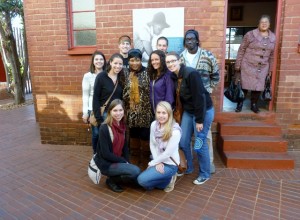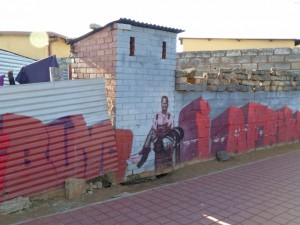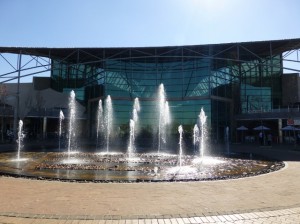For our first few days in Johannesburg, South Africa it remained really cold! My roommate and I resorted to huddling near a hot place in our room at night and in the morning, but during the day it wasn’t so bad and we were kept busy with speakers, tours, and group discussions.
 We started with a lecture from a man named Molefi Mataboge on the liberation struggle in South Africa. He gave us a timeline and a good foundation to start with but also shared his personal testimony—particularly his struggle to overcome his anger and learn to speak. He then accompanied us on a visit to a township called Soweto (standing for South Western Township) and he explained that townships were created to push blacks out of the cities and into these settlements to be kept away from the Whites and Afrikaaners (descendants of Dutch immigrants) and their occupations. Soweto is the largest of these townships and it has been the site of intense uprisings. It is also the home to leaders Nelson Mandela and Desmond Tutu, but faces devastating economic hardships, astonishing rates of crime, and inadequate education. Molefi was patient and humorous as he answered questioned after question from us. He is incredibly knowledgeable and shared his passion for education with us. I felt honored to have learned so much from him in just a few short days.
We started with a lecture from a man named Molefi Mataboge on the liberation struggle in South Africa. He gave us a timeline and a good foundation to start with but also shared his personal testimony—particularly his struggle to overcome his anger and learn to speak. He then accompanied us on a visit to a township called Soweto (standing for South Western Township) and he explained that townships were created to push blacks out of the cities and into these settlements to be kept away from the Whites and Afrikaaners (descendants of Dutch immigrants) and their occupations. Soweto is the largest of these townships and it has been the site of intense uprisings. It is also the home to leaders Nelson Mandela and Desmond Tutu, but faces devastating economic hardships, astonishing rates of crime, and inadequate education. Molefi was patient and humorous as he answered questioned after question from us. He is incredibly knowledgeable and shared his passion for education with us. I felt honored to have learned so much from him in just a few short days.
We visited the house of Nelson Mandela and coincidentally were in a tour group with his daughter and grandson. Though a little ‘star-struck’ some of my group members managed to ask for a picture and struck up a conversation with his grandson.
 Then we visited The Hector Pieterson Museum, dedicated to a passionate young student who marched among his classmates to stop the forced teaching of all subjects in Afrikaans in their schools. Here is a little background that I had learned and that was shared by Hector Pieterson’s sister, Atoinette Sithole (who we were lucky enough to hear speak): Afrikaans is a derivative of the Dutch language. The language of the people who brutally pushed blacks into townships, made them prisoners to the apartheid, and the people who are responsible for many deaths of blacks. In other words, the language of these students’ oppressors. Many of the teachers could not effectively teach in this language and this law would only further benefit Afrikaaners and marginalize black students. This was the last straw for the unfairly treated students. After long planning, hidden from parents, they organized a march, but were met with police force who opened fire on students. Hector Pieterson, a 13 year old boy, was the first to be reported dead and the image captured of him being carried alongside his confused and horrified sister has been an iconic symbol of the liberation struggle. Atoinette does not view her brother as a hero or matyr, but appreciates the museum as it gave her an opportunity to cope and comfort that he did not die in vain.
Then we visited The Hector Pieterson Museum, dedicated to a passionate young student who marched among his classmates to stop the forced teaching of all subjects in Afrikaans in their schools. Here is a little background that I had learned and that was shared by Hector Pieterson’s sister, Atoinette Sithole (who we were lucky enough to hear speak): Afrikaans is a derivative of the Dutch language. The language of the people who brutally pushed blacks into townships, made them prisoners to the apartheid, and the people who are responsible for many deaths of blacks. In other words, the language of these students’ oppressors. Many of the teachers could not effectively teach in this language and this law would only further benefit Afrikaaners and marginalize black students. This was the last straw for the unfairly treated students. After long planning, hidden from parents, they organized a march, but were met with police force who opened fire on students. Hector Pieterson, a 13 year old boy, was the first to be reported dead and the image captured of him being carried alongside his confused and horrified sister has been an iconic symbol of the liberation struggle. Atoinette does not view her brother as a hero or matyr, but appreciates the museum as it gave her an opportunity to cope and comfort that he did not die in vain.
Finally, we visited the Maponya mall, named after the man that owns it and adorned with an elephant (the symbol of his tribe). He owns other car dealerships and ensures that they all stay in Soweto. We had lunch here at a South African chain called Nando’s, which had Portugese chicken and mealie (grilled corn).
This was just our first day!

Leave a Reply